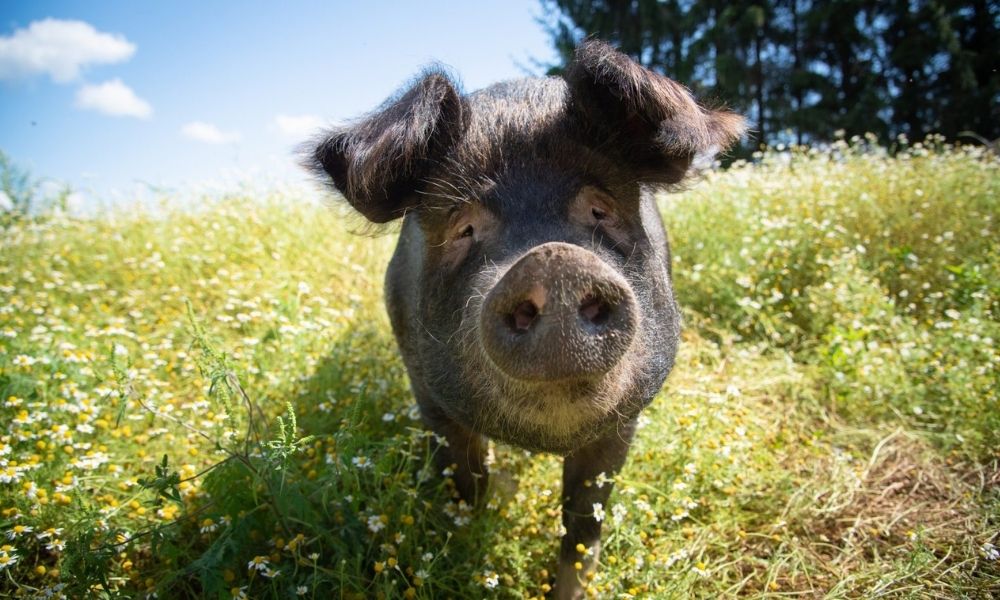If you’ve ever visited a true farmed animal sanctuary, you know that they’re typically run by some of the most passionate and dedicated people on the planet.
These are the people who will drive six hours in the middle of the night to a specialty clinic with a newly-rescued baby calf showing signs of sickness.
They’ll meticulously administer expensive medications or treatments multiple times a day for chickens with infected feet or heart issues, whip up individualized diets and enrichment exercise routines for overweight pigs, and sit in pastures for hours on end to regain the trust of abused sheep.
When animal residents pass, typically at a way-too-early age, they’ll mourn – deeply. And many of their employers will give them bereavement time, knowing that letting go of these sweet and personable beings can hurt just as much as losing human loved ones — or maybe knowing that sanctuary employees see way too much death.
We all love happy rescue stories — as do the sanctuary caregivers who do everything in their power to provide happy and fulfilling lives to their animals.
But that’s only one part of the story.
Most farmed animals raised in industrialized facilities have been genetically manipulated, bred, and fed to grow faster and produce more than their bodies naturally can so that humans can consume more milk, eggs, meat, and other animal byproducts.
What happens to their bodies when they live past their agriculture-prescribed “slaughter” ages — typically when they are still babies, at only a few months old — can be summed up in a single word: Breakdown.
Grace Garner, the wellness assistant manager at Farm Sanctuary in New York, spoke with Lady Freethinker over Zoom about some of the chronic issues that animal residents, through no fault of their own or their caregivers, prevalently face from their human-selected genetics and resulting too-large sizes: early-onset arthritis, hoof infections, reproductive cancers, other cancers, and heart issues.
While Garner was vivacious, passionate, and cheerful for most of the call, her contagious smile hitched, and what appeared to be a weariness crept into the corners of her eyes, as she detailed the lives of quirky residents lost too young.
“Sanctuary is a place of healing, a place to allow animals to grow old and to be around each other and to not be isolated in crates or cages,” she said. “But it is also a place of sadness, because we are not dealing with animals who are healthy. Unfortunately, sanctuary is also a place where a lot of them die because of what’s been done to them.”
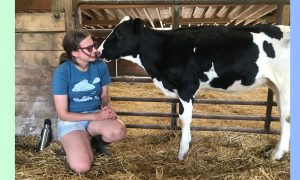
Grace Garner with Pippi (Grace Garner/Courtesy of Farm Sanctuary)
Lynn Printy and Britt Janssen, co-founder and farm manager of JP Farm Animal Sanctuary in Litchfield, Connecticut, said many of their permanent residents also suffer from chronic conditions. Too often, that pain reaches a point where the animals’ quality of life is questionable.
“It can get severe,” Printy said. “When the animals can’t get up, when you see them in a lot of pain, when they stop eating, we can’t let that suffering continue.”
The toll of premature deaths or mercy-driven euthanasias on caregivers can be what Garner described delicately as “extensive.” For Printy’s team, the resulting feelings can be anger at the injustice or a sense of urgency to make compassionate change for the animals.
“We’re trying to educate in a gentle way,” Printy told LFT. “But I feel like we (as a species) are not moving fast enough on this. We need to take a look at what we’re doing to this planet.”
The two sanctuaries shared some of the stories of their beloved residents, whose incredible resilience allowed them to leave legacies of love in the hearts of many.
We share their stories to honor their remarkable lives, both past and present, but also to highlight a sad reality — that even when animals raised for human consumption get out of the slaughterhouses, they never really escape.
To learn more about Farm Sanctuary or support their residents, you can visit their website here. To check out JP Farm Animal Sanctuary or support their residents, you can visit their website here. And to help ALL animals, you can choose compassionate plant-based options.
ALLIE
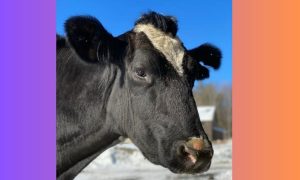
Allie (Courtesy of JP Farm Animal Sanctuary)
Allie came to JP Farm Animal Sanctuary as an 11-year-old cow — already an anomaly in the dairy industry, which typically slaughters mother cows by age 6.
The gentle and loving Holstein immediately caused staff’s hearts to “explode with happiness” as she settled in with her new herd, gravitating toward bovines Bruce and Evan, with whom she’d get “a little giddy,” according to staff.
Allie’s forgiving nature, her affection toward humans, and her peaceful presence in her pasture most definitely have helped change many lives, including that of a visitor who immediately quit eating dairy — and then started cutting out other animal products — after meeting her.
“We had a volunteer who was married to a meat eater, and they came for a private tour,” Printy related. “One of the first stops is Allie. After we moved to the next cow, he remained back to stay with Allie, and he stayed with her for the entire visit. After that visit, our volunteer noticed her husband hadn’t eaten dairy or meat for a week. Then it was three months. And now it’s been over a year.”
Allie’s happy nature belies a sad past. By the time she arrived at JP, she already had been forcibly impregnated — and had her babies taken away from her — 10 times.
Because of her large size, she now suffers from hip dysplasia and a painful hoof condition, which staff have tried to ameliorate with a special boot that helps her walk and a pain management schedule.
“I hate to say it, but she is in pain,” Printy said. “She’s also very smart. She’s learned that if she looks at us and starts mooing, we’ll come to her. It’s like she’s saying, ‘I can’t get up today, can you please bring me my hay?’”
Allie knows she has that connection with JP’s staff — and when they comply to her wishes, she’ll “get very excited” and thank them as a reward, Printy said.
ORLANDO
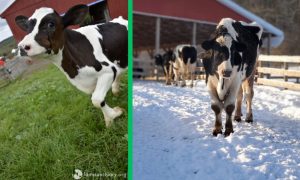
Orlando as a youth and as an adult (Courtesy of Farm Sanctuary/Kayla Perry)
Orlando and eight other male calves were bought at a livestock auction by a farmer wanting to raise “cheap” beef. The calves were kept in a dank and fetid basement and became sickly, and when the farmer couldn’t afford their care, he started shooting them, according to Farm Sanctuary.
When authorities intervened because the farmer had violated his probation by discharging a firearm, Farm Sanctuary stepped in and rescued the surviving calves — including Orlando, who went from being the “goofiest” of the calves to the goofiest of adults.
“Orlando was very sweet with visitors,” Garner said. “He was a popular guy. He’d always bob his head for food and make us laugh.”
But Orlando had developed arthritis that got worse. One day, staff noticed he was stuck down and couldn’t get up. They had to help Orlando make his way to the barn and checked on him throughout the night. The next morning, Orlando was down again, and staff knew it was time to end his suffering, Garner said.
“I think that is the hardest part of this for us, because it’s not just that we can’t out-do what the industry has done, but also because the animal’s bodies break down before their minds,” she said.
MISSY AND CHARLIE
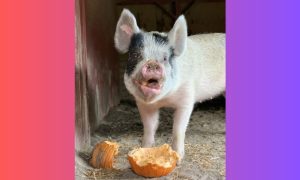
Charlie (Courtesy of Farm Sanctuary)
Missy the pig’s profile on Farm Sanctuary’s website notes she was born on Halloween and had a “grim and haunting start to life.”
Until her rescue, Missy was kept in a solitary pen. Unhappy with her circumstances, a rebellious Missy would break free at “any chance she got,” according to her profile.
Eventually, the farmer who was exploiting Missy decided to send her to slaughter, but a neighbor secured her release and then connected her to Farm Sanctuary, where she reportedly greeted staff with “happy grunts.” She quickly became a permanent resident and the “top pig” in a yard with two other porcine pals, Pickles and Mouse, whom she oversaw as a “firm but fair ruler.”
Sadly, this colorful queen ended up with arthritis before she even turned two, although she is definitely making the most of her life at the sanctuary, Garner said.
Charlie (pronounced SHAR-lee), another much beloved pig, loved to play. She loved her brothers. She was extremely active, Garner said.
Charlie ended up with a hoof infection and arthritis, common issues in adult pig — which Garner attributed to “really bad genetics and just being so big” — but not for a pig so young. Charlie died at age 3.
“I had a co-worker who told me, ‘That one, that just hit me hard,’” Garner said. “What made Charlie’s death so difficult was that she was so young to have these issues.”
DJ

DJ, then and now (Courtesy of JP Farm Animal Sanctuary)
DJ arrived at JP Farm Animal Sanctuary as a 5-month-old, 200-pound survivor of a college agriculture program that required students to teach the animals a trick before they were sent to slaughter.
Janssen said DJ has been “friendly from the first night” and is a huge aficionado of kisses, hugs, and attention. He quickly became beloved by staff and volunteers as a curious and smart pig with “a cute wiggle and a big voice.”
DJ has undergone treatment at Cornell University College of Veterinary Medicine twice — once for skin cancer, for which he required cryotherapy treatments, and also for a hoof issue, Janssen said.
PAMELA, CECELIA, and KAI
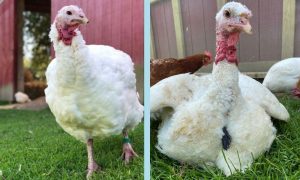
Pamela (left) and Kai (right) (Grace Garner/Courtesy of Farm Sanctuary)
Pamela, a sweet and sassy turkey rescued from a factory farm, had endured painful procedures — including being debeaked. But she quickly became known as “The Lover” to Farm Sanctuary’s staff.
“She was sassy with other turkeys, but she loved people,” Garner said with a laugh.
Pamela’s bio describes her as “the sweetest and most affectionate member of our flock” – one who enjoyed cuddles and pets from “anyone who was willing to give them.”
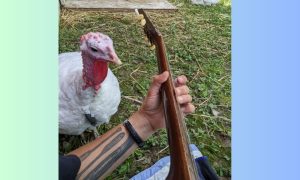
Cecelia (Isabella Padrón/Courtesy of Farm Sanctuary)
Kai and Cecelia, two of the other bird residents, also had distinct personalities.
“Cecelia was the chattiest of the group,” Garner said. “Kai would come right up to you and sunbathe beside you. She just loved attention. ”
Pamela, Kai, and Cecelia all developed arthritis and required pain medications as they aged before they passed away, Garner said.
THE BROOKLYN 6 AND THE GOLDEN GIRLS
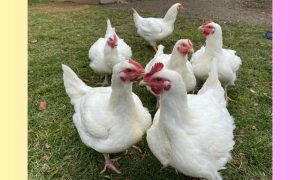
The Brooklyn 6 (Courtesy of JP Farm Animal Sanctuary)
JP Farm Animal Sanctuary rescued six hens — Sunshine, Joy, Isabella, Savannah, Rene, and Hope, whom they nicknamed “The Brooklyn 6” — from a religious slaughter ritual known as Kaporos, or Kapparot.
In spite of their past, the girls took great enjoyment out of life, particularly while eating corn, fruit, and seeds. They also frequently made their caretakers laugh.
“The best thing is the hens run toward us when we come into the gate and greet us with such enthusiasm, our hearts are filled with joy knowing that they can live a happy, free life!” staff wrote in the hens’ profile on the sanctuary’s website.
Unfortunately, all of The Brooklyn 6 arrived at the sanctuary with respiratory or heart issues and have since passed away.
Four lovable hens currently at the sanctuary — Blanche, Dorothy, Sophia, and Rose — also were rescued from the ritualistic slaughter. Staff affectionately call them “The Golden Girls.”
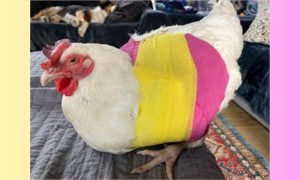
Blanche (Courtesy of JP Farm Animal Sanctuary)
But the girls also have their health issues. Blanche recently broke her wing, but because of an existing heart condition isn’t a good candidate for surgery.
Those health concerns are typical of many of the birds that JP Farm Animal Sanctuary has rescued.
“They’ve been bred to have these gigantic breasts for people’s meat,” Printy said. “Because they’ve been bred to be gigantic, they often hunch or lean over when they try to walk.”
These Stories Aren’t Anomalies
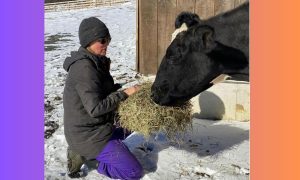
Allie (Courtesy of JP Farm Animal Sanctuary)
Farm Sanctuary reports that farmed animals are among the most abused creatures on earth, with 77 billion animals slaughtered worldwide in 2018 alone, with many kept in hellish factory farms where they endured extreme confinement, painful mutilation, and were bred to grow fast and large before being cruelly slaughtered at a young age.
Both of the sanctuaries that talked with LFT could have talked for hours about the residents they’ve cared for, loved, and lost, as well as the intensive and dedicated efforts of staff to give animals the highest-quality lives they can.
At the end of the day, it’s about the animals — and the animals are what keep them going.
“That’s the silver lining in sanctuary,” Garner said. “Even if they have a shorter life than they should have, you’re giving them the best possible life you can for the time they have left. It doesn’t necessarily make it better in the moment, but that’s the saving grace and why people stay. It’s to give them the best life that we can.”

